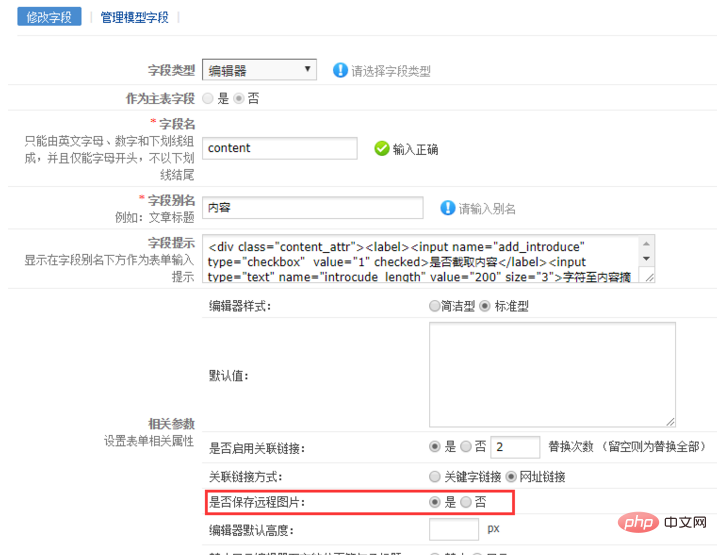Was soll ich tun, wenn phpcms keine Remote-Bilder speichern kann?

Was soll ich tun, wenn phpcms keine Remote-Bilder speichern kann?
phpcms v9 kann standardmäßig nur Remote-Bilder des HTTP-Protokolls speichern. Natürlich können Sie auch festlegen, ob diese selbst gespeichert werden sollen. Sie wissen nicht, wo Sie es einstellen sollen? Backend->Content->Model Management->Article Model-Field Management->Content Field-Modify, siehe Bild unten:

Zurück zum Betreff, es gibt jetzt viele Aus Sicherheitsgründen hat die Website das https-Protokoll aktiviert, und die von diesen Websites kopierten Bilder sind ebenfalls https. In diesem Fall kann phpcms die Remote-Bilder nicht automatisch speichern. Ändern Sie einfach die Fillurl-Funktion in der Datei phpcms/libs/classes/attachment.class.php wie folgt:
/**
* 补全网址
*
* @paramstring$surl源地址
* @paramstring$absurl相对地址
* @paramstring$basehref网址
* @returnstring网址
* 增加对远程https协议下图片的本地化保存
*/
function fillurl($surl, $absurl, $basehref = '') {
if($basehref != '') {
$preurl = strtolower(substr($surl,0,6));
if($preurl=='http://' || $preurl=='https://' || $preurl=='ftp://' ||$preurl=='mms://' || $preurl=='rtsp://' || $preurl=='thunde' || $preurl=='emule://'|| $preurl=='ed2k://')
return $surl;
else
return $basehref.'/'.$surl;
}
$i = 0;
$dstr = '';
$pstr = '';
$okurl = '';
$pathStep = 0;
$surl = trim($surl);
if($surl=='') return '';
$urls = @parse_url(SITE_URL);
$HomeUrl = $urls['host'];
$BaseUrlPath = $HomeUrl.$urls['path'];
$BaseUrlPath = preg_replace("/\/([^\/]*)\.(.*)$/",'/',$BaseUrlPath);
$BaseUrlPath = preg_replace("/\/$/",'',$BaseUrlPath);
$pos = strpos($surl,'#');
if($pos>0) $surl = substr($surl,0,$pos);
if($surl[0]=='/') {
$okurl = 'http://'.$HomeUrl.'/'.$surl;
} elseif($surl[0] == '.') {
if(strlen($surl)<=2) return '';
elseif($surl[0]=='/') {
$okurl = 'http://'.$BaseUrlPath.'/'.substr($surl,2,strlen($surl)-2);
} else {
$urls = explode('/',$surl);
foreach($urls as $u) {
if($u=="..") $pathStep++;
else if($i<count($urls)-1) $dstr .= $urls[$i].'/';
else $dstr .= $urls[$i];
$i++;
}
$urls = explode('/', $BaseUrlPath);
if(count($urls) <= $pathStep)
return '';
else {
$pstr = 'http://';
for($i=0;$i<count($urls)-$pathStep;$i++) {
$pstr .= $urls[$i].'/';
}
$okurl = $pstr.$dstr;
}
}
} else {
$preurl = strtolower(substr($surl,0,6));
if(strlen($surl)<7)
$okurl = 'http://'.$BaseUrlPath.'/'.$surl;
elseif($preurl=="http:/" || $preurl=="https:" ||$preurl=='ftp://' ||$preurl=='mms://' || $preurl=="rtsp://" || $preurl=='thunde' || $preurl=='emule:'|| $preurl=='ed2k:/')
$okurl = $surl;
else
$okurl = 'http://'.$BaseUrlPath.'/'.$surl;
}
$preurl = strtolower(substr($okurl,0,6));
if($preurl=='ftp://' || $preurl=='mms://' || $preurl=='rtsp://' || $preurl=='thunde' || $preurl=='emule:'|| $preurl=='ed2k:/') {
return $okurl;
} else {
$okurl = preg_replace('/^(http:\/\/)/i','',$okurl);
$okurl = preg_replace('/^(https:\/\/)/i','',$okurl);
$okurl = preg_replace('/\/{1,}/i','/',$okurl);
return 'http://'.$okurl;
}
}Unter diesen ist https neu und existierte vorher nicht.
PHP-Website für Chinesisch, eine große Anzahl kostenloser PHPCMS-Tutorials, willkommen zum Online-Lernen!
Das obige ist der detaillierte Inhalt vonWas soll ich tun, wenn phpcms keine Remote-Bilder speichern kann?. Für weitere Informationen folgen Sie bitte anderen verwandten Artikeln auf der PHP chinesischen Website!

Heiße KI -Werkzeuge

Undresser.AI Undress
KI-gestützte App zum Erstellen realistischer Aktfotos

AI Clothes Remover
Online-KI-Tool zum Entfernen von Kleidung aus Fotos.

Undress AI Tool
Ausziehbilder kostenlos

Clothoff.io
KI-Kleiderentferner

AI Hentai Generator
Erstellen Sie kostenlos Ai Hentai.

Heißer Artikel

Heiße Werkzeuge

Notepad++7.3.1
Einfach zu bedienender und kostenloser Code-Editor

SublimeText3 chinesische Version
Chinesische Version, sehr einfach zu bedienen

Senden Sie Studio 13.0.1
Leistungsstarke integrierte PHP-Entwicklungsumgebung

Dreamweaver CS6
Visuelle Webentwicklungstools

SublimeText3 Mac-Version
Codebearbeitungssoftware auf Gottesniveau (SublimeText3)

Heiße Themen
 1384
1384
 52
52
 So springen Sie zur Detailseite in phpcms
Jul 27, 2023 pm 05:23 PM
So springen Sie zur Detailseite in phpcms
Jul 27, 2023 pm 05:23 PM
So springen Sie zur Detailseite in phpcms: 1. Verwenden Sie die Header-Funktion, um einen Sprunglink zu generieren. 2. Durchlaufen Sie die Inhaltsliste. 3. Rufen Sie den Titel und den Detailseitenlink des Inhalts ab.
 Welches Framework ist phpcms?
Apr 20, 2024 pm 10:51 PM
Welches Framework ist phpcms?
Apr 20, 2024 pm 10:51 PM
PHP CMS ist ein PHP-basiertes Open-Source-Content-Management-System zur Verwaltung von Website-Inhalten. Zu seinen Merkmalen gehören Benutzerfreundlichkeit, leistungsstarke Funktionalität, Skalierbarkeit, hohe Sicherheit und kostenloses Open Source. Es kann Zeit sparen, die Website-Qualität verbessern, die Zusammenarbeit verbessern und Entwicklungskosten senken und wird häufig auf verschiedenen Websites wie Nachrichten-Websites, Blogs, Unternehmenswebsites, E-Commerce-Websites und Community-Foren verwendet.
 WeChat Login-Integrationsleitfaden: PHPCMS Practical Combat
Mar 29, 2024 am 09:18 AM
WeChat Login-Integrationsleitfaden: PHPCMS Practical Combat
Mar 29, 2024 am 09:18 AM
Titel: WeChat Login-Integrationsleitfaden: PHPCMS in Aktion Im heutigen Internetzeitalter ist Social Login zu einer der wesentlichen Funktionen einer Website geworden. Als eine der beliebtesten sozialen Plattformen in China wird die Login-Funktion von WeChat auch von immer mehr Websites genutzt. In diesem Artikel wird erläutert, wie die WeChat-Anmeldefunktion in die PHPCMS-Website integriert wird, und es werden spezifische Codebeispiele bereitgestellt. Schritt 1: Registrieren Sie ein WeChat Open Platform-Konto. Zuerst müssen wir ein Entwicklerkonto auf der WeChat Open Platform registrieren und die entsprechenden Entwicklungsberechtigungen beantragen. Anmelden [Offene WeChat-Plattform]
 Ist PHPCMS nicht kostenlos?
Mar 01, 2023 am 10:24 AM
Ist PHPCMS nicht kostenlos?
Mar 01, 2023 am 10:24 AM
phpcms ist nicht völlig kostenlos. phpcms ist ein Open-Source-CMS-System, aber Open Source bedeutet nicht, dass es kostenlos ist. Es gibt zwei Versionen: die kostenlose Version und die kommerzielle Version. Die kostenlose Version ist auf den privaten, nicht kommerziellen Gebrauch beschränkt, während die kommerzielle Version den Erwerb einer Lizenz erfordert Verwenden Sie es für Forschungszwecke, und wenn es sich um eine kommerzielle Anwendung handelt, müssen Sie eine bestimmte Gebühr zahlen.
 Was bedeutet phpcms?
Apr 20, 2024 pm 10:39 PM
Was bedeutet phpcms?
Apr 20, 2024 pm 10:39 PM
PHPCMS ist ein kostenloses Open-Source-Content-Management-System (CMS), das Folgendes bietet: Open Source, Modularität, Flexibilität, Benutzerfreundlichkeit und Community-Unterstützung. Es kann zum Erstellen verschiedener Arten von Websites verwendet werden, darunter Unternehmenswebsites, E-Commerce-Websites, Blogs und Community-Foren. Zu den technischen Anforderungen gehören: PHP 5.6 oder höher, MySQL-, MariaDB- oder PostgreSQL-Datenbank und Apache- oder Nginx-Webserver.
 Welche PHPCMS-Versionen gibt es?
Jun 14, 2023 pm 01:13 PM
Welche PHPCMS-Versionen gibt es?
Jun 14, 2023 pm 01:13 PM
Es gibt zwei bekannte Versionen von PHPCMS, nämlich: 1. PHPCMS4, das benutzerdefinierte URL-Regeln unterstützt, ist schön und einfach zu verwenden und verfügt über viele Front-End-Plug-Ins, die Funktionen frei erweitern können . phpCMS2008R1, das die Verwaltung mehrerer Sprachen und mehrerer Standorte unterstützt. Der Manager ist praktisch, flexibel, sehr leichtgewichtig und läuft schnell.
 Sicherheitseinstellungsstrategie für PHPCMS-Benutzernamen enthüllt
Mar 14, 2024 pm 12:06 PM
Sicherheitseinstellungsstrategie für PHPCMS-Benutzernamen enthüllt
Mar 14, 2024 pm 12:06 PM
Strategie zur Einstellung der Sicherheit von PHPCMS-Benutzernamen enthüllt Bei der Website-Entwicklung war die Sicherheit von Benutzerkonten schon immer ein Aspekt, auf den Entwickler großen Wert legen. Auch die Sicherheitseinstellungen des Benutzernamens sind von entscheidender Bedeutung, da der Benutzername nicht nur die Anmeldeinformationen des Benutzers darstellt, sondern auch die persönlichen Daten des Benutzers preisgeben und sogar Sicherheitsrisiken verursachen kann. In diesem Artikel wird die Strategie zur Einstellung der Benutzernamensicherheit in PHPCMS erläutert und spezifische Codebeispiele bereitgestellt, auf die sich Entwickler beziehen können. 1. Verhindern Sie die Verwendung gebräuchlicher Benutzernamen. Um die Sicherheit von Benutzernamen zu verbessern, sollten Entwickler verhindern, dass Benutzer übermäßig viele Benutzernamen verwenden
 Welche Datenbank verwendet phpcms?
Feb 21, 2023 pm 06:57 PM
Welche Datenbank verwendet phpcms?
Feb 21, 2023 pm 06:57 PM
phpcms verwendet eine MySQL-Datenbank. phpcms ist ein PHP-Open-Source-Website-Managementsystem, das auf PHP+MYSQL als technischer Basis entwickelt wurde. PHPCMS V9 verwendet die OOP-Methode zum Aufbau des grundlegenden Betriebssystems. Die unterstützte PHP-Version ist PHP5 und höher, und die unterstützte MYSQL-Version ist MySql 4.1 und höher.




